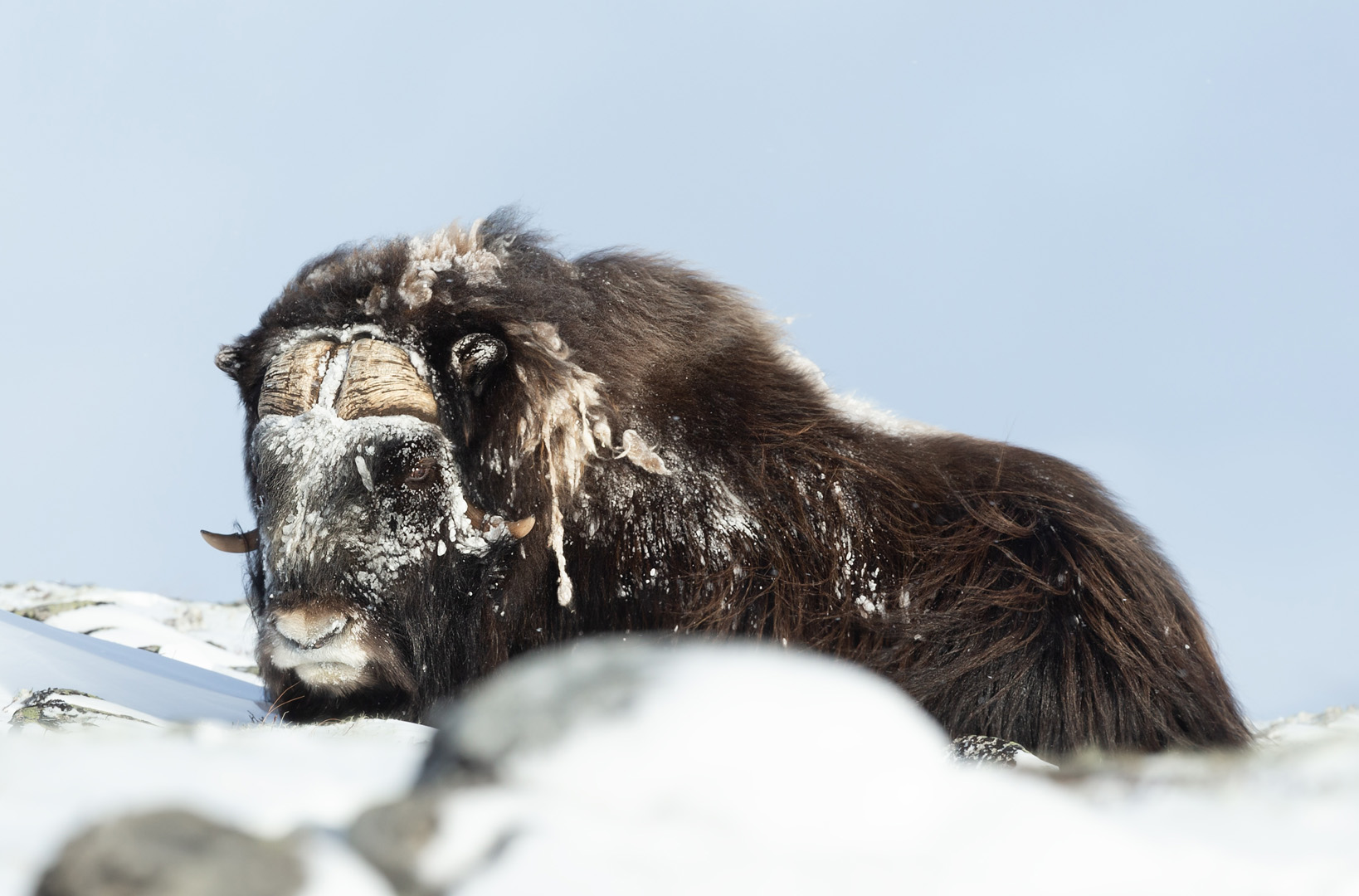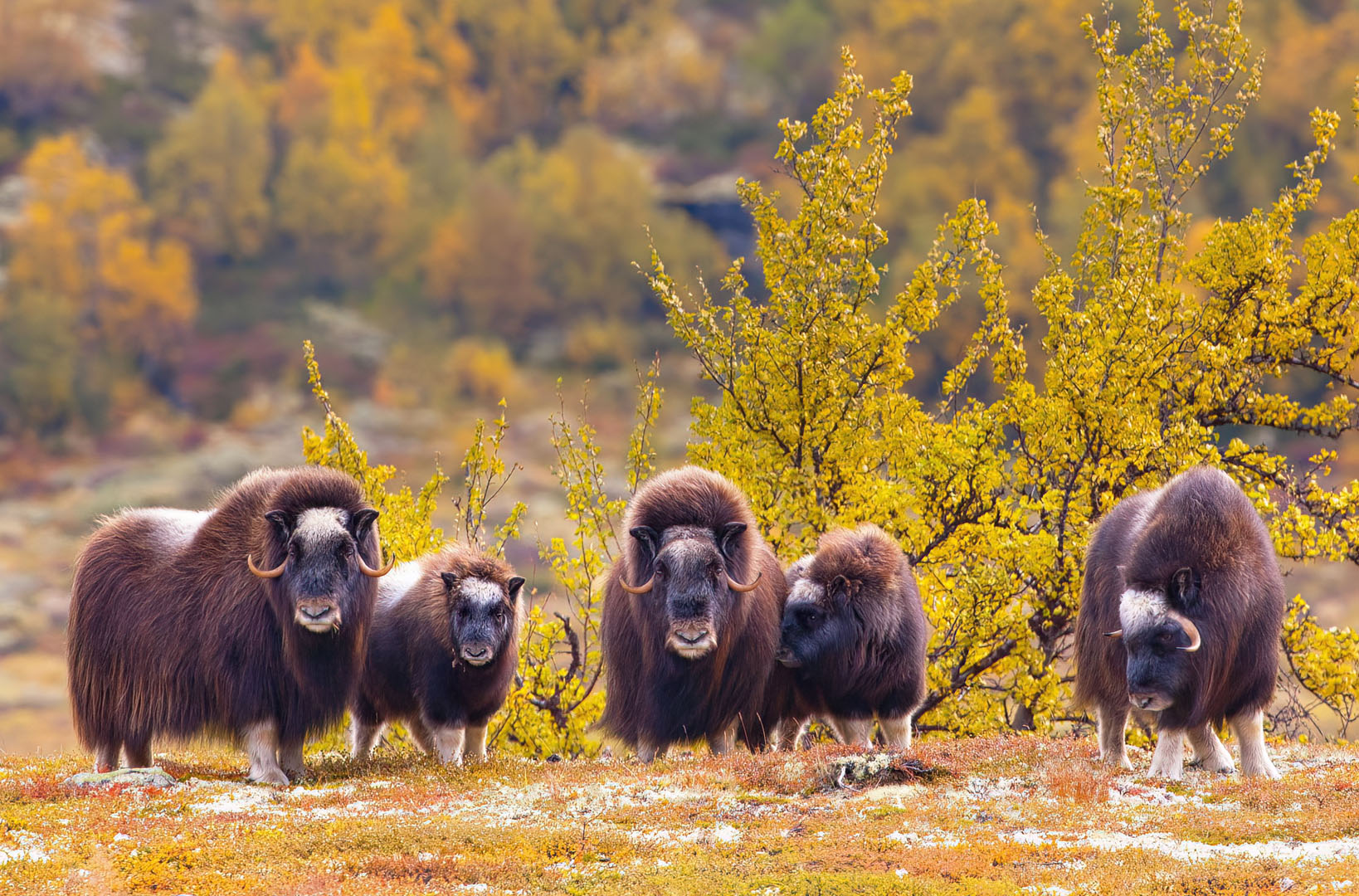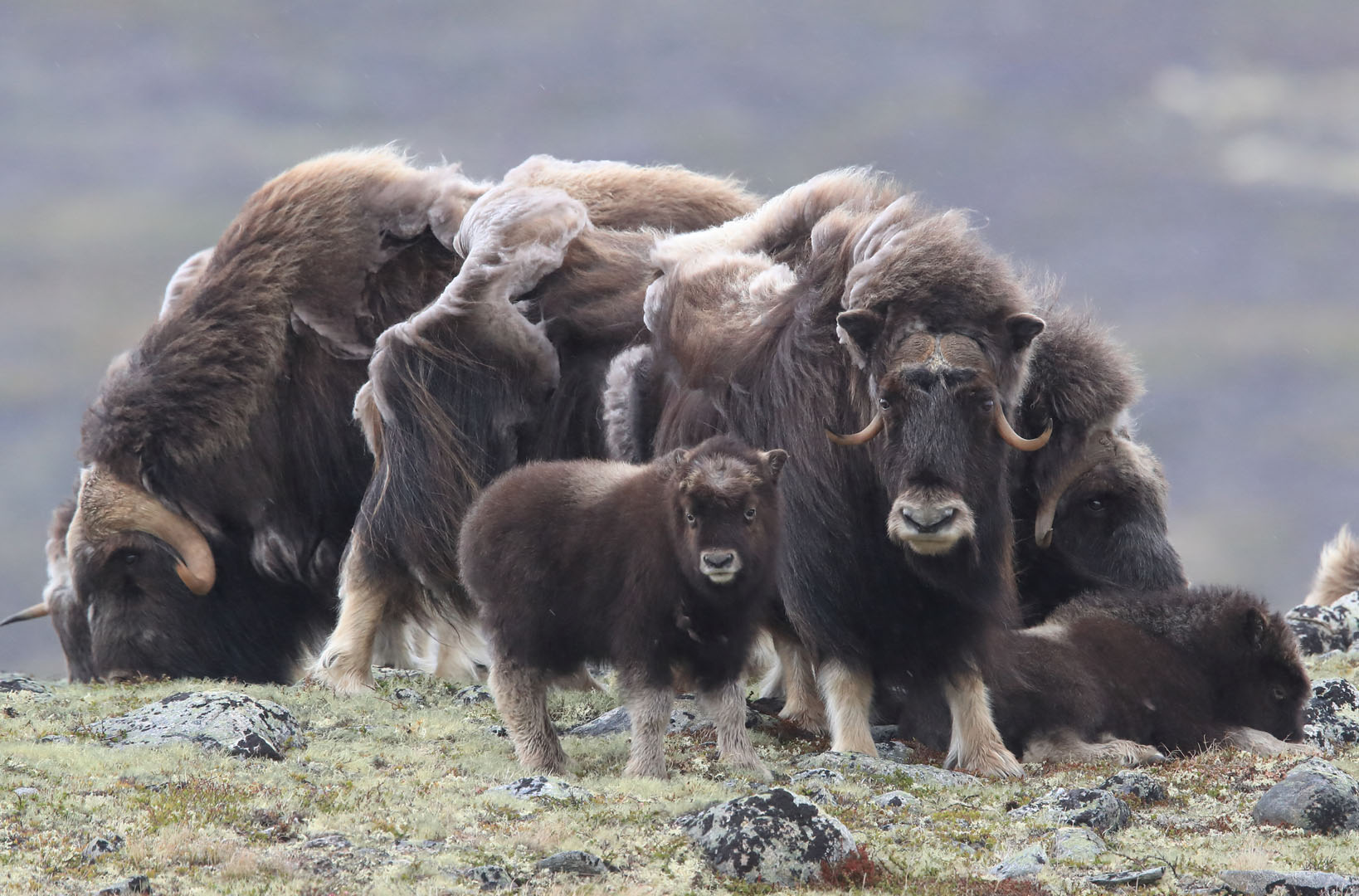$0.00
No products in the cart.

The Arctic is a region is known for its extreme temperatures, vast ice-covered landscapes, and unique wildlife. Among these unique creatures that thrive in these conditions is the muskox (Ovibos moschatus). The muskox is a fascinating large bodied, horned animal that has adapted to survive in one of the harshest environments on Earth. Berkes F, Farkas describes the Muskox as a “living fossil from a past age” and a relic that joins early hunter gatherer to the modern world.
The muskox nomenclature in Latin, Ovibos moschatus roughly translates to “musky sheep-ox”, also spelled musk ox and musk-ox, and in plural muskoxen or musk oxen (Grubb, P. (2005). “Order Artiodactyla”).
In reference to the animal itself, the muskox is referred by the Woods Cree as “mâthi-môs” and “mâthi-mostos” translated to “ugly moose” and “ugly bison”, respectively (Houston, Clarence Stuart; Houston, Stuart; Ball, Tim; Houston, Mary (October 2003)) where its Inuktitut name “umingmak” translates to “the bearded one” (Flood, P. F.; Abrams, S. R.; Muir, G. D.; Rowell, J. E. (August 1989)).
As a species, the muskox belongs to the taxonomic classification of the Bovidae Subfamily: Caprinae and the genus Ovibos.

Muskoxen are even-toed (artiodactyla), hoofed ungulates native to the Arctic they are members of the Bovidae family. Although they may visually resemble the bison, they belong to the caprinae sub-family, interestingly, this makes them more closely related to sheep and goats then cows or bison (websource: uaf.edu).
The muskox it is noted for its thick coat, curled flat horns and the strong odour emitted by males during the rut, from which its name derives.
The musky odour of the muskox has the effect of attracting females during mating season, referred to as the rut. During this time, muskoxen are harem breeders, with males fighting for dominance to breed multiple females. Their rut typically starts mid- August and runs to mid-September, and calves are born in April/May (web source: uaf.edu) Following an eight-month gestation period, a female will give birth to a single calf, which after only a few hours of being born, is able to stand and walk on its own. The calf stays with its mother for about two years, where it will be protected by the herd. Muskoxen live in herds of 12–24 in the winter and 8–20 in the summer (Tener, J. S. (1965). They do not hold territories, but they do mark trails using preorbital glands located, as the name would suggest, a gland situated forward of the eye (Owen-Smith, N. (1977). During the summer, muskoxen live in wet areas, such as river valleys, moving to higher elevations in the winter to avoid deep snow. Muskoxen will eat grasses, arctic willows, woody plants, lichens, and mosses. When food is abundant, they prefer succulent and nutritious grasses in an area. Willows are the most commonly eaten plants in the winter. Muskoxen require a high threshold of fat reserves in order to conceive, which reflects their conservative breeding strategy. Winter ranges typically have shallow snow to reduce the energy costs of digging through snow to reach forage (Gunn, A.; Forchhammer, M. (2016)).
Male and female muskoxen have separate age-based hierarchies, with mature oxen being dominant over juveniles. Typically, dominant oxen tend to get access to the best resources (Lent, Peter C (1988) and will displace subordinates from patches of grass during the winter. Muskox bulls assert their dominance in many different ways. One is a “rush and butt”, in which a dominant bull rushes a subordinate from the side with its horns, and will warn the subordinate animal (Wilkinson, P. F.; Shank, C. C. (1976). Bulls will also roar, swing their heads in a fluid motion side to side as well as paw the ground (Lent, Peter C (1988). Not dissimilar to other species, dominant bulls sometimes treat subordinate bulls like cows. A dominant bull will tap a subordinate with its foreleg, an action they have been observed doing to cows during mating (Reinhardt, V. (2005). “Courtship behaviour among musk-ox males kept in confinement”). Dominant bulls will also mock copulate subordinates and sniff their genitals. In an article by D. R Gray in1986 published as “Standing his ground: How the muskox survives the rigours of an Arctic winter” he states that a subordinate bull can change his status by charging a dominant bull.
The appearance of a muskox is rather unique, certainly specialised to the elements in which they inhabit. The muskox has a bulky appearance, with a shoulder height of around 1.2 to 1.5 meters and a length of 2.4 to 3 meters, including its tail, of which is 8 – 10 centimetres long and hidden by thick fur.
Muskoxen are generally sexually dimorphic in body size, meaning that there is a clear difference in male and females, with males being larger and heavier than females, and having a thick horn boss. Adult males, are referred to as bulls and the female, cows. While they do share some basic physical similarities with the bison, they are typically much smaller. Bulls can weigh anywhere between 300 to 400 kilograms, while cows will typically weigh around 200 to 300 kilograms making it significantly smaller than the bison.

The most notable physical feature of the muskox is its dense and long winter coat, which helps it withstand the extreme cold of the Arctic. The outer layer consists of coarse guard hairs that protect against wind and moisture, while the underfur is exceptionally soft and provides insulation. This adaptation enables the muskox to maintain its body heat even in temperatures as low as -40° Celsius.
Both male and female muskoxen possess horns, but the horns of males are larger and more impressive. The horns, with their large helmet like “bosses,” are broad and curved, growing from the sides of the head and then curving downward. They can reach lengths of up to 80 centimetres and resemble that of a cape buffalo in some instances. They serve as defensive weapons during territorial disputes and predator encounters. (The IUCN Red List of Threatened Species. (2016).
The muskox has a short, stout tail and a humped shoulder profile. Its legs are relatively short but sturdy, allowing it to navigate through the deep snow. The hooves are broad and adapted for walking on both snow and rough terrain, adaptions that have made it ideal to thrive in the artic (Environment Canada. (2005). Muskoxen in Canada: Status and Trends).
The modern muskox is the last member of a line of ovibovines that first evolved in temperate regions of Asia and adapted to a cold tundra environment late in its evolutionary history. Muskox ancestors with sheep-like high-positioned horns (horn cores being mostly over the plane of the frontal bones, rather than below them as in modern muskoxen) first left the temperate forests for the developing grasslands of Central Asia during the Pliocene, expanding into Siberia and the rest of northern Eurasia. Later migration waves of Asian ungulates that included high-horned muskoxen reached Europe and North America during the first half of the Pleistocene. The first well known muskox, the “shrub-ox” Euceratherium, crossed to North America over an early version of the Bering Land Bridge two million years ago and prospered in the American southwest and Mexico. Euceratherium was larger yet more lightly built than modern muskoxen, resembling a giant sheep with massive horns, and preferred hilly grasslands.
During the Pleistocene period, muskoxen were much more widespread. Fossil evidence shows that they lived across the Siberian and North American Arctic, from the Urals to Greenland (Switek, Brian. “Prehistoric DNA Reveals the Story of a Pleistocene Survivor, the Muskox.”). The ancestors of today’s muskoxen came across the Bering Land Bridge to North America between 200,000 and 90,000 years ago (Wildlife Management Advisory Council (North Slope) fact sheet) During the Wisconsinan, modern muskox thrived in the tundra south of the Laurentide Ice Sheet, in what is now the Midwest, the Appalachians and Virginia, while distant relatives Bootherium and Euceratherium lived in the forests of the Southern United States and the western shrubland, respectively (“KGS–Guidebook 5–Wisconsinan Mammalian Faunas”) Though they were always less common than other Ice Age megafauna, muskox abundance peaked during the Würm II glaciation 20,000 years ago and declined afterwards, especially during the Pleistocene/Holocene extinction event, where its range was greatly reduced and only the populations in North America survived. The last known muskox population in Europe died out in Sweden 9,000 years ago (Lent, Peter C. (1999)). In Asia, muskox persisted until just 615-555 BCE in Tumat, Sakha Republic (Plasteeva, N. A., Gasilin, V. V., Devjashin, M. M., & Kosintsev, P. A. (2020)).

Following the disappearance of the Laurentide Ice Sheet, the muskox gradually moved north across the Canadian Arctic Archipelago, arriving in Greenland from Ellesmere Island at about 350 AD, during the late Holocene. Their arrival in northwestern Greenland probably occurred within a few hundred years of the arrival of the Dorset and Thule cultures in the present-day Qaanaaq area. Human predation around Qaanaaq may have restricted muskoxen from moving down the west coast, and instead kept them confined to the northeastern fringes of the island (Plasteeva, N. A., Gasilin, V. V., Devjashin, M. M., & Kosintsev, P. A. (2020)).
Efforts have been undertaken to redistribute the muskox throught their previous range. For instance, the species was reintroduced from Banks Island to the Dovre mountain range of Norway in 1932 but were hunted to extinction there during the Second World War. It was reintroduced to Norway in 1947; this population expanded into Härjedalen, Sweden, in 1971.
In 1913, workers building a railway over Dovrefjell found two fossil muskox vertebrae. This led to the idea of introducing muskoxen to Norway from Greenland. The first release in the world was made on Gurskøy outside Ålesund in 1925–26. They were muskoxen caught by Norwegian seal-hunting boats in Greenland. The animals colonized the island, but eventually died out there. Another attempt to introduce the muskox to Svalbard also failed. Seventeen animals were released in 1929 by Adventfjorden on West Spitsbergen. In 1940, the herd numbered 50, but in the 1970s, the whole herd disappeared. In September 1932, polar researcher Adolf Hoel conducted another experiment, importing 10 muskoxen to Dovrefjell. This herd survived until World War II, when they were hunted and exterminated. In 1947 and later, new animals were released. A small group of muskoxen from Dovrefjell migrated across the national border to Sweden in 1971 and established themselves in Härjedalen, whereby a Swedish herd was established.
In Russia, animals imported from Banks and Nunivak were released in the Taymyr Peninsula in 1974 and 1975, and some from Nunivak were released in Wrangel Island in 1975. Both locations are north of the Arctic Circle. By 2019 the population on Wrangel Island was about 1100, and the Taymyr Peninsula, about 11,000–14,000. A few muskoxen herds migrated from the Taymyr Peninsula far to the south to the Putorana Plateau. Once established, these populations have been, in turn, used as sources for further reintroductions in Siberia between 1996 and 2010. One of the last of these actions was the release of six animals within the Pleistocene Park project area in the Kolyma River in 2010, where a team of Russian scientists led by Sergey Zimov aims to prove that muskoxen, along with other Pleistocene megafauna that survived into the early Holocene in northern Siberia, did not disappear from the region due to climate change, but because of human hunting.

Ancient muskox remains have never been found in eastern Canada, although the ecological conditions in the northern Labrador Peninsula are suitable for them. In 1967, 14 animals were captured near Eureka on Ellesmere Island by the Institute for Northern Agricultural Research (INAR) and brought to a farm in Old Fort Chimo Kuujjuaq, northern Quebec, for domestication to provide a local cottage industry based on qiviut, a fine natural fibre. Subsequently, 54 animals from the farm were released in three places in northern Quebec between 1973 and 1983, and the remaining were ceded to local zoos. Between 1983 and 1986, the released animals increased from 148 to 290, at a rate of 25% per year, and by 2003, an estimated 1,400 muskoxen were in Quebec. Additionally, 112 adults and 25 calves were counted in the nearby Diana Island in 2005, having arrived there by their own means from the mainland. Vagrant adults are sometimes spotted in Labrador, though no herds have been observed in the region (“Pleistocene Park Underway: Home for Reborn Mammoths?”).
The primary predators of muskoxen are arctic wolves, which may account for up to half of all mortality for the species. Other occasional predators, likely mainly predators of calves or infirm adults, can include grizzly bears and polar bears and wolverines (Lent, Peter C (1988)).
Of course, as with most animals, they share a close prey relationship with humans. Muskox is reported to have been an important food source for Chandalar Kutchin (Gwich’in) [12] and Inuit [21, 24, 26, 27, 30]. Muskox is thought to have been particularly useful to Chipewyan [2], Iglulik Inuit [30] and Caribou Inuit [26] when caribou was scarce. Yellowknives (Dene), Dogrib and Hare (Sahtu) seldom hunted muskox due to the strong flavor of the flesh and difficulty in hunting (Ross BR: An Ethnobiology Source Book).
Copper and Iglulik Inuit hunted muskox from June to late fall (Damas D: Environment, History, and Central Eskimo Society). Netsilik Inuit hunted them in fall and winter. Other Inuit communities and Dogrib hunted muskox in spring before break-up of the ice while Slave Lake and Bear Lake cultures (Sahtu) hunted in summer (Animal Life in Greenland – an introduction by the tourist board)

To hunt muskox, Inuit of Dorset were said to have used a lance made of bone. Iglulik Inuit, Netsilik Inuit Caribou Inuit and Baffin Island Inuit used dogs to round up muskoxen and killed the animals with bow and arrow or lance. Inuit were reported to kill musk oxen with relative ease using a lance as their dogs held the herd at bay. More primitive cultures of Greenland hunted with wooden lances and the Utkuhikhalingmiut, a localized group of Netsilik Inuit, were thought to have driven herds into lakes before spearing them, again using primitive materials (“Muskox”. moskussafari.no). interestingly, in a gurther symbiotic relationship, the Dogrib were said to have used dogs and guns (Grubb, P. (2005). “Order Artiodactyla”).
The Copper (Dene) were thought to have dried the meat to be consumed when on the land. Inland and coastal Inuit consumed not only the meat, but also the partially digested stomach (rumen) contents as a secondary source of food (Weaver B: Canadian Inuit Food and Foodways). Some cultures of the far north often described the odour of the flesh as disagreeable if the animal was not in good condition or was lean, but enjoyed meat from fatter animals, the adult leg bone marrow and foetal calves (Russel F: Explorations in the Far North).
Apart from the flesh, Inuit also used various parts of the muskox. The skin was used as a runner for sleds, the horn was used as a ladle for a variety of purposes and as a leister when fishing. Cultures of the far north sold skins to traders who in turn had caps etc. made from them (Russel F: Explorations in the Far North). Yellowknives, Dogrib and Hare made robes and caps from the calfskin and flyswatters from the tail. Dogrib made robes from the hide, and spoons from the horns (elm J, Lurie NO). Copper Inuit used the horn to make bows and the skin to cover platforms of entrances. Netsilik relied on muskox bone (because of lack of driftwood) to make sealing harpoons and points, tool handles, composite bow, arrow points, leisters and fishing harpoons, spear and ice chisel points, ice scoops, many specialized instruments associated with breathing-hole seal hunting, and cross bars for sleds. Muskox horn was used as a blubber pounder to break down the frozen blubber to be used in oil lamps. Caribou Inuit used horns to make soup ladles, ice scoops, bows and leister prongs; the skin was used for bedding and tenting
The muskox is classified as a species of “Least Concern” on the International Union for Conservation of Nature (IUCN) Red List.

And while populations have faced fluctuations in the past due to unregulated hunting, and habitat loss conservation efforts and protective measures have helped stabilize and recover populations in certain regions. The species is protected under national legislation in countries where it occurs, and there are international agreements in place to regulate its hunting and trade, where applicable. The muskox population in North America is relatively stable, with the largest numbers found in Canada. Alaska also has a population of animals generally considered as strong, primarily in areas such as the Arctic National Wildlife Refuge and the Yukon Delta National Wildlife Refuge. In Greenland, the muskox population has increased over the years, thanks to successful reintroduction programs and good management practices.
In Russia, the muskox population is more fragmented, with small populations scattered across north-eastern Siberia and the Russian Arctic. The exact population size and status of muskoxen in Russia may vary between different regions due to limited data and the vast and remote nature of their habitat.
Musk ox hunting opportunities offer an adventure for nature enthusiasts and thrill-seeking hunters with emphasis on travel to remote and wild places. With their impressive size and majestic presence, these prehistoric-looking creatures draw hunters to remote regions. Arctic regions like Greenland and parts of North America provide safe locations for Musk ox hunts. For those seeking an experience, Musk ox offer a unique blend of basic wilderness exploration, and a connection with one of nature’s most awe-inspiring animals.